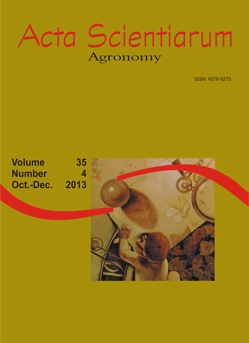<b>Early selection in sugarcane family trials via BLUP and BLUPIS procedures</b> - doi: 10.4025/actasciagron.v35i4.16430
Resumo
The objective of this study was to compare early selection in sugarcane families through the best linear unbiased prediction (BLUP) and simulated individual best linear unbiased prediction (BLUPIS) procedures. We tested 80 full-sib families in an incomplete block experimental design. Statistical analyses were performed using the mixed model methodology. The following traits were determined from the first rattoon: tons of stalks per hectare (TSH), percentage of soluble solids w/w in the juice (Brix), and tons of brix per hectare (TBH). Variance components were estimated by restricted maximum likelihood (REML), and the genotypic values of the families were predicted by BLUP and BLUPIS. The BLUPIS procedure suggested the selection of 30 families with a total of 344 individuals for TBH and gain with a selection intensity of 28%. The correlation between BLUPIS and true BLUP was 0.83, 0.93 and 0.91, for Brix, TSH and TBH, respectively, being validated with data from sugarcane. The BLUPIS procedure demonstrated an advantage in selecting families based on the total harvest of the plot, different from the BLUP procedure that requires the measurement of all individuals present in the plot.
Downloads
DECLARAÇÃO DE ORIGINALIDADE E DIREITOS AUTORAIS
Declaro que o presente artigo é original, não tendo sido submetido à publicação em qualquer outro periódico nacional ou internacional, quer seja em parte ou em sua totalidade.
Os direitos autorais pertencem exclusivamente aos autores. Os direitos de licenciamento utilizados pelo periódico é a licença Creative Commons Attribution 4.0 (CC BY 4.0): são permitidos o compartilhamento (cópia e distribuição do material em qualqer meio ou formato) e adaptação (remix, transformação e criação de material a partir do conteúdo assim licenciado para quaisquer fins, inclusive comerciais.
Recomenda-se a leitura desse link para maiores informações sobre o tema: fornecimento de créditos e referências de forma correta, entre outros detalhes cruciais para uso adequado do material licenciado.




















































